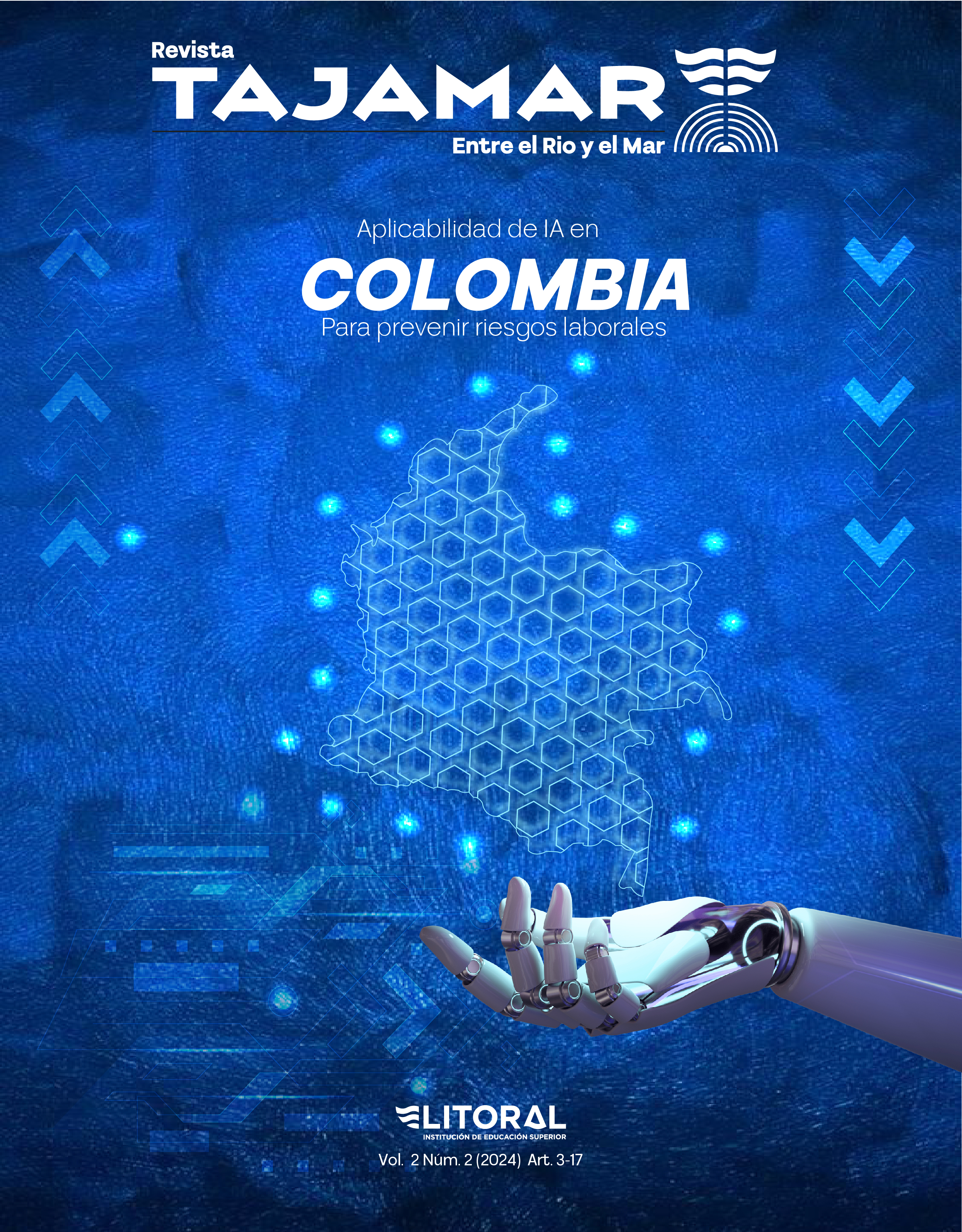APLICABILIDAD DE LA INTELIGENCIA ARTIFICIAL EN COLOMBIA PARA PREVENIR LOS RIESGOS LABORALES: REVISIÓN SISTEMÁTICA
Contenido principal del artículo
Resumen
introducción: El uso de la inteligencia artificial ha tomado relevancia en los últimos años debido a la capacidad de realizar tareas automatizadas, sin control humano, sin embargo, en Colombia el uso de estas tecnologías es moderado en el espacio laboral y de prevención de riesgos. ii) Objetivo: revisar en la literatura científica la importancia de la aplicabilidad de la inteligencia artificial en Colombia para prevenir los riesgos laborales en los procesos productivos. iii) metodología: La tipología de investigación es documental-bibliográfica, con enfoque cualitativo, aplicando la técnica hermenéutica, en combinación de análisis de co-citacion de autores de relaciones bibliométricas y cienciometrico, y añadiendo el método de revisión sistemática PRISMA. iv) resultados: El análisis determinó la importancia abordada a la investigación relacionada en seguridad y salud en el trabajo en Colombia, donde autores han contribuido en temas como riesgos psicológico laboral, prevención de accidentes, analítica de datos en accidentes y predicción en tiempo real, v) conclusiones: El país a nivel de investigación debe adoptar nuevas tendencias descritas en el estudio bibliométrico internacional y de autores como Li H, quien está a la vanguardia en este objetivo investigativo.
Descargas
Detalles del artículo

Esta obra está bajo una licencia internacional Creative Commons Atribución-NoComercial-SinDerivadas 4.0.
Licencia CC
La revista tajamar utiliza la Licencia Creative Commons:
Atribución-NoComercial-SinDerivadas 4.0 Internacional (CC BY-NC-ND 4.0)
Usted es libre de:
1) Compartir — copiar y redistribuir el material en cualquier medio o formato.
Bajo los siguientes términos:
-
Atribución — Usted debe dar crédito de manera adecuada, brindar un enlace a la licencia, e indicar si se han realizado cambios. Puede hacerlo en cualquier forma razonable, pero no de forma tal que sugiera que usted o su uso tienen el apoyo de la licenciante.
-
NoComercial — Usted no puede hacer uso del material con propósitos comerciales.
-
SinDerivadas — Si remezcla, transforma o crea a partir del material, no podrá distribuir el material modificado.

Citas
Al Najada, H., & Mahgoub, I. (2016). Big vehicular traffic data mining: Towards accident and congestion prevention. 2016 International Wireless Communications and Mobile Computing Conference (IWCMC), 256–261. https://doi.org/10.1109/IWCMC.2016.7577067
Amaya-Mejia, L. M., Duque-Suarez, N., Jaramillo-Ramirez, D., & Martinez, C. (2022). Vision-based safety system for barrierless human-robot collaboration. IEEE International Conference on Intelligent Robots and Systems, 2022-October, 7331–7336. https://doi.org/10.1109/IROS47612.2022.9981689
Arana-Landín, G., Laskurain-Iturbe, I., Iturrate, M., & Landeta-Manzano, B. (2023). Assessing the influence of industry 4.0 technologies on occupational health and safety. Heliyon, 9(3), e13720. https://doi.org/10.1016/j.heliyon.2023.e13720
Donthu, N., Kumar, S., Mukherjee, D., Pandey, N., & Lim, W. M. (2021). How to conduct a bibliometric analysis: An overview and guidelines. Journal of Business Research, 133, 285–296. https://doi.org/10.1016/j.jbusres.2021.04.070
Effendi, D. N., Irwandani, Anggraini, W., Jatmiko, A., Rahmayanti, H., Ichsan, I. Z., & Rahman, M. M. (2021). Bibliometric analysis of scientific literacy using VOS viewer: Analysis of science education. Journal of Physics: Conference Series, 1796(1), 012096. https://doi.org/10.1088/1742-6596/1796/1/012096
Emaminejad, N., & Akhavian, R. (2022). Trustworthy AI and robotics: Implications for the AEC industry. Automation in Construction, 139, 104298. https://doi.org/10.1016/j.autcon.2022.104298
Fang, W., Ding, L., Love, P. E. D., Luo, H., Li, H., Peña-Mora, F., Zhong, B., & Zhou, C. (2020). Computer vision applications in construction safety assurance. Automation in Construction, 110, 103013. https://doi.org/10.1016/j.autcon.2019.103013
Fernández, J. C., Corrales, L. B., Hernández, F. H., Benítez, I. F., & Núñez, J. R. (2021). A fuzzy logic proposal for diagnosis of multiple incipient faults in a power transformer. In Lecture Notes in Computer Science, 13055 LNCS, 187–198. https://doi.org/10.1007/978-3-030-89691-1_19
Gutierrez-Osorio, C., González, F. A., & Pedraza, C. A. (2022). Deep learning ensemble model for the prediction of traffic accidents using social media data. Computers, 11(9), 126. https://doi.org/10.3390/computers11090126
Han, H., Zhang, L., Wu, X., & Qiao, J. (2019). An efficient second-order algorithm for self-organizing fuzzy neural networks. IEEE Transactions on Cybernetics, 49(1), 14–26. https://doi.org/10.1109/TCYB.2017.2762521
He, R., Li, X., Chen, G., Chen, G., & Liu, Y. (2020). Generative adversarial network-based semi-supervised learning for real-time risk warning of process industries. Expert Systems with Applications, 150, 113244. https://doi.org/10.1016/j.eswa.2020.113244
Jebelli, H., Choi, B., & Lee, S. (2019). Application of wearable biosensors to construction sites. II: Assessing workers’ physical demand. Journal of Construction Engineering and Management, 145(12), 04019080. https://doi.org/10.1061/(ASCE)CO.1943-7862.0001710
Jebelli, H., Habibnezhad, M., Khalili, M. M., Fardhosseini, M. S., & Lee, S. (2020). Multi-level assessment of occupational stress in the field using a wearable EEG headset. Construction Research Congress 2020: Safety, Workforce, and Education - Selected Papers from the Construction Research Congress 2020, 140–148. https://doi.org/10.1061/9780784482872.016
Koc, K., Ekmekcioğlu, Ö., & Gurgun, A. P. (2022). Accident prediction in construction using hybrid wavelet-machine learning. Automation in Construction, 133, 103987. https://doi.org/10.1016/j.autcon.2021.103987
Koc, K., Ekmekcioğlu, Ö., & Gurgun, A. P. (2023). Determining susceptible body parts of construction workers due to occupational injuries using inclusive modelling. Safety Science, 164, 106157. https://doi.org/10.1016/j.ssci.2023.106157
Lee, E. J., Ko, B. C., & Nam, J. Y. (2016). Recognizing pedestrian’s unsafe behaviors in far-infrared imagery at night. Infrared Physics & Technology, 76, 261–270. https://doi.org/10.1016/j.infrared.2016.03.006
Lee, S., Koo, B., Yang, S., Kim, J., Nam, Y., & Kim, Y. (2022). Fall-from-height detection using deep learning based on IMU sensor data for accident prevention at construction sites. Sensors, 22(16), 6107. https://doi.org/10.3390/s22166107
Li, X., Chen, G., Khan, F., & Xu, C. (2019). Dynamic risk assessment of subsea pipelines leak using precursor data. Ocean Engineering, 178, 156–169. https://doi.org/10.1016/j.oceaneng.2019.02.009
Liu, Y., Habibnezhad, M., Shayesteh, S., Jebelli, H., & Lee, S. (2021). Paving the way for future EEG studies in construction: Dependent component analysis for automatic ocular artifact removal from brainwave signals. Journal of Construction Engineering and Management, 147(8), 04021087. https://doi.org/10.1061/(ASCE)CO.1943-7862.0002097
Morales, V., Machado, A., Arias, M., Sánchez, C., Nieto, W., & Gómez, Y. (2022). An approach to estimate the orientation and movement trend of a person in the vicinity of an industrial robot. In Communications in Computer and Information Science, 1532 CCIS, 128–142. https://doi.org/10.1007/978-3-030-99170-8_10
Moral-Muñoz, J. A., Herrera-Viedma, E., Santisteban-Espejo, A., & Cobo, M. J. (2020). Software tools for conducting bibliometric analysis in science: An up-to-date review. Profesional de La Información, 29(1). https://doi.org/10.3145/epi.2020.ene.03
